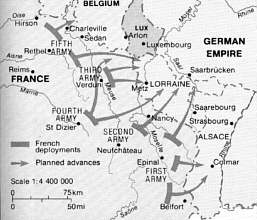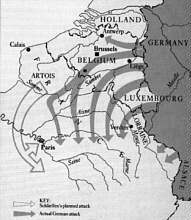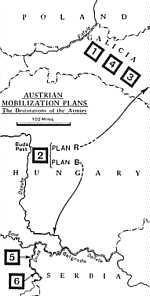1905-1914 - War Plans
See also: ø Military Plans and The First World War
| Overview |
The instability of Europe and the varied alliances caused the major powers to develop plans that would guide the military in the event of a war - plans where nothing would be left to chance. These intricate plans included rigid timetables for troop movements and carefully prepared lists of objectives. They were strict with very little margin for error. This was a limiting factor because the technology of the day was wrought with error.
Each side was aware, to some extent, of the other's plans. The spies had done their jobs well. It was just a matter of whether you believed your opponents were capable of successfully executing their plan.
There is no doubt that the very existence of these plans contributed to the outbreak of war in 1914. The tension that existed at the time was only increased by the knowledge of what your potential, or imagined, enemy had in store for you. Paranoia was a real part of the political climate and it was rampant.
ø Colonel E.M House's Report to President Wilson - May 1914
Have a look at Colonel House's situation report. It's quite short and to the point on the political/military climate in Europe in the spring of 1914.
|
 |
 |
French Plan XVII
from Winter, The Experience of World War I |
| French Plan XVII |
The French, never able to dispel the humiliating defeat of 1871, put first and foremost in their plan the retaking of the lost provinces of Alsace-Lorraine.
The plan was based on the teachings of Lieutenant Colonel Louzeau de Grandmaison, director of the Bureau of Military Operations and prominent member of the "School of Attack". The plan was adopted by the General Staff in 1913 and further developed by Joffre right up to the summer of 1914.
Plan XVII was based on the notion of elan, the utter spirit to win. To best understand this notion, let's look at some of the catch phrases from the day:
- "The will to conquer is the first condition of victory."
- "Offensive to the maximum!"
- "Offensive without hesitation!"
- "The offensive alone leads to positive results."
The plan, which was full of flaws, had one major flaw in particular - it massed the French army to the south, away from where the brunt of the German attack would come. It couldn't have been worse for the French or better for the Germans.
|
 |
 |
German Schlieffen Plan
from Livesey, Great Battles of World War I |
| German Schlieffen Plan |
This plan, named for it's originator, Count Alfred von Schlieffen, was a reaction to the German notion of encirclement. Any war for Germany would be a two front war. This plan would ensure a quick, 42 days to be exact, victory over France before their ally, Russia, could complete its mobilization. This would allow the German army to then concentrate all forces to the east in order to crush their second enemy, Russia.
Four armies, one million men, would comprise the arc. The path of which was characterized by its creator:
"Let the last man on the right brush the channel with his sleeve."
The weak part of this plan was the intentional violation of Belgian neutrality. Both Germany and Britain were among the signers of the 1839 treaty ensuring this neutrality. Bismarck warned that this violation would be folly in that it would drag Britain into the conflict.
The map above shows the planned arc towards the Channel. The darker arrows show the actual path of invasion. Moltke did not heed Schlieffen's dying words:
"Keep the right wing strong!"
See also: ø Description of the Schlieffen Plan
|
 |
 |
| Other War Plans |

This section was contributed by Wendell Vest
|
- Austro-Hungarian War Plans
- Austria-Hungary's war plans also had two variations; one against
the Balkans , and one against both Russia and the Balkans. The
first plan was considered the most probable and concentrated
three armies to invade Serbia and Montenegro, while three other
armies took defensive positions in Galicia against a possible
Russian attack. Variation R, the plan which was put into effect
on 1 August concentrated four armies against Russia on the
Galician frontier, and only two against the Serbians.2
- Belgian War Plans
- Belgium's field army of 117,000 men would concentrate west of
the Meuse to defend Antwerp.The main effort of the field army
would be to avoid battle with superior forces, and to maintain
contact with Antwerp. It also mustered some 67,000 fortress
troops to man the forts at Liege, Namur and Antwerp. Liege and
Namur defended the principal crossings on the Meuse River and
were vital to the defense of Belgium.4
- British War Plans
- The British, unlike the continental powers did not have
universal service. Therefore, their available army forces on
mobilization were limited to their regular army fleshed out with
their immediately available reserves. This consisted of two army
corps of three divisions each, a cavalry division and supporting
artillery and service forces. Their plans called for this force
to be transported to the continent and then transported by
French railroads to a concentration area on the left flank of
the French near Maubege. It was planned that this force would be
available on the 21st day after mobilization.5
- Russian War Plans
- The Russian mobilization, which triggered the war, supported two
variations of war plans. One variation was to be used in the
event of a war with Austria-Hungary and Germany only, and the
other was to be used if Germany attacked France. The latter
variation was the one used and was designed to attack East
Prussia from concentrations in the Polish Salient by the 15th
day after mobilization. It also mobilized four additional armies
against Austria-Hungary in Galicia. The Northwestern Group
concentrated in the Polish Salient was to consist of the First
and Second Armies and their mission was to defeat the German
forces in East Prussia and seize German territory as far as the
River Vistula. The Southwestern Group consisted of four Russian
Armies. Its mission was to inflict a decisive defeat on the
Austria-Hungarian armies concentrated in Galicia. The Russian
mobilization plan envisioned 42 mobilized infantry divisions by
the 15th day and 78 by the 35 day of mobilization.1
- Serbian War Plans
- Serbian War plans called for the entire Serbian army of five
active division increased to ten on mobilization to be
concentrated in the region around Belgrade ( the capital of
Serbia and close to the border with Austria-Hungary) and to
strike the Austrian forces after their tactical plan had been
devulged.3
|
| Naval War Plans |
- General
- Naval plans of the powers were nowhere near as precise
as the plans for army forces. The following is a brief summary
of the plans of each naval power.
- British
- The British Royal Navy, being the most powerful force
afloat, planned the following tasks for its fleet. Engage the enemy battle fleet and destroy it.
Protect the movement of the British Expeditionary Force to the continent
Protect the British Isles and the coast of France from attack from the sea.
Assist French Naval forces in the Mediterranean Sea to protect
their convoys from North Africa. Seek out and destroy hostile naval forces and commerce raiders
throughout the world. Blockade the enemy coast and prevent contraband from being
supplied by sea. It was planned to concentrate the main British battle fleet
called The Grand Fleet at Inverness, Scapa Flow and The Firth of Forth. All of these bases were on the northeast coast of the British Isles,across the North Sea from Germany.6
- German
- The German High Seas Fleet, based in the main German
bases at Kiel and Wilhelmshaven, planned to engage the British
fleet in a war of attrition, making full use of naval mines,
torpedoes, and its light forces. And then, at a moment when the
odds were more even, to engage it in battle. German naval forces
in other areas would destroy enemy commerce.7
- French
- The French fleet based primarily in the Mediterranean
Sea planned to protect its North African convoys and to engage
and destroy the Italian and Austrian battle fleet.
- Russian
- The Russian Fleet based at Kronstadt in the Gulf of
Finland planned a defensive war against the German Baltic fleet.
|
1 McEntee, G.L. Military History of The World War, Charles Scribner's Sons, New York 1943,p.27
2 ibid.,pp29-30
3 Ibid.,pp31-32
4 ibid.,pp.16-17
5 Callwell,Major General Sir C.E.; Field Marshall Sir Henry Wilson, His Life and Diaries. Cassell and Company,Ltd. London,1927. p159
6 Potter,E.B. and Nimitz, C.W. Seapower, A Naval History. Prentice-Hall Inc. Englewood Cliffs, N.J. pp.394-396
7 McEntee,loc. cit. p.39
|
|